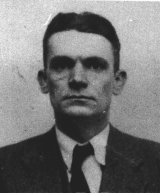

Charles Critchfield, a mathematical physicist, brought a wealth of ordnance experience to the Laboratory.
Navy Capt. William Parsons became the first Ordnance Division Leader at the Laboratory. Both are early Laboratory badge photos.
Military guns are simple in design and a known quantity by virtue of their long use by the armies and navies of the world. The decision to use a gun to assemble active material in a fission bomb came about because gun technology is so well known.
During the July 1942 conference hosted by J. Robert Oppenheimer at Berkeley, Calif., it was taken for granted that a large caliber gun would be used to shoot two pieces of uranium into a supercritical assembly. After the discovery of plutonium, the use of guns became more problematic. Light element impurities could cause predetonation if sufficient assembly velocity was not achieved. Despite this concern, the elegant simplicity of gun technology gave Oppenheimer cause for optimism as Los Alamos came into existence. And despite the simplicity of gun assembly, a great deal of uncertainty remained about the nuclear materials and what the final product would look like.
Because of such uncertainty, Oppenheimer took personal control of gun development. As he noted, "At the present time our estimates are so ill founded that I think it better for me to take responsibility for putting them [design specifications] forward." With two types of fissile material to use, Oppenheimer faced a crucial first decision. Should the Laboratory develop a gun capable of using plutonium, the more difficult material to use, and adjust the gun to use uranium? Or, should two different guns be developed simultaneously?
Oppenheimer chose to develop the plutonium gun, code named "Thin Man" and then make the necessary changes to accommodate uranium. He believed that uranium presented few metallurgical problems and any changes in the gun would be minor.
With the help of Richard Tolman of the National Defense Research Committee, Oppenheimer proceeded with an experimental program. Their most significant impact on this program was choosing two key persons: Edwin Rose and Charles Critchfield. Rose, an engineer and gun designer, observed that a gun weapon could be delivered by aircraft if much of the steel used in the normal construction of guns was eliminated.
Since a fission gun would be fired only once, much of the steel used to ensure safety after repeated firings was unnecessary.
Critchfield, a mathematical physicist, brought a wealth of ordnance experience to the Laboratory. Critchfield realized that the Naval Gun Factory needed as much as six months to build the full-scale guns needed by the Laboratory. He suggested that time could be saved by testing at reduced scale using 20mm anti-aircraft guns and 3-inch naval cannon. These could be procured immediately. When the full-scale guns arrived, only the most promising nuclear designs would need to be tested.
Oppenheimer continued his direct supervision of the gun program until June 1943 when Navy Capt. William Parsons became the first Ordnance Division Leader at the Laboratory.
Work on Thin Man continued until July 1944 when Emilo Segré's experiments on the spontaneous fissioning of plutonium proved that a gun could not be used to assemble this material. Oppenheimer made the decision to abandon Thin Man and redirect much of the Laboratory's resources to develop the implosion method.
After the reorganization, gun work focused on uranium assembly, code named "Little Boy." Oppenheimer's earlier decision in 1943 to concentrate on Thin Man on the belief that a uranium gun did not present major technical problems proved prophetic. Little Boy was developed with few major complications.
- Roger Meade
Laboratory archivist Roger Meade is this week's guest columnist. He has recently published a collaborative effort, "Critical Assembly," a technical history of the Laboratory from 1943 to 1945.
Next: Emilio Segre leads the research on spontaneous fission